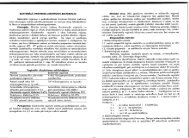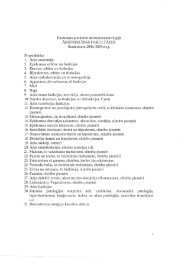PHYSICS
n - susliks.lv
n - susliks.lv
- No tags were found...
You also want an ePaper? Increase the reach of your titles
YUMPU automatically turns print PDFs into web optimized ePapers that Google loves.
Glaucoma arises from an abnormal increase in fluid pressure<br />
inside the eyeball. The pressure increase can lead to a swelling and<br />
distortion of the lens causing pronounced myopia.<br />
22.3. BIOLUMINESCENCE<br />
The ability to emit light is found in a diverse cross-section of<br />
organisms - bacteria, peridineae, medusae, crustaceans, molluscs,<br />
tunicate, fish, and insects. Bioluminescence is an enzymatically<br />
catalyzed chemiluminescence - luminescence caused by<br />
chemical reactions. There is considerable biochemical diversity in<br />
the systems responsible for bioluminescence. Single cells (photocytes)<br />
to complex glands (photophores) may be used by animals.<br />
Fig. 22.13. Firefly (Pyrophorus),<br />
The most common biochemical process involves the luciferin-lucifrom the American tropics, with two<br />
[erase system (as in bioluminescent bacteria). The reaction involves<br />
light organs on its thorax behind<br />
the oxidative breakdown of a high-energy, complex organic molecule<br />
(luciferin) by an enzyme (luciferase) which releases photons<br />
the eyes (Hader, 1987)<br />
of light.<br />
The best-known role of bioluminescence is in communication<br />
among sexual partners (e.g., fireflies). Each species emits a<br />
specific light signal pattern that consists of single flashes or a modulated<br />
emission from 5 to over 40 flashes per second (fig.<br />
bacterium phosphoerum, Pyrocystis,<br />
22.12).<br />
~<br />
....<br />
~<br />
...<br />
~<br />
tJ<br />
~<br />
lO:<br />
=<br />
e<br />
.... =<br />
=<br />
~<br />
0"=<br />
~..<br />
:.:::<br />
~<br />
~ 0.1 0.2 0.3 0.4 0.5 0.6 0.7<br />
Time, s<br />
Fig. 22.12. Light signals of a male Photinus evanescens from Jamaica:<br />
11 pulses per second with a frequency of 20 Hz<br />
Another important behavioral factor is the timing of signaling<br />
which differs among species. For example, each species of firefly<br />
166<br />
has its own time niche. Precise timing increases the chances of<br />
sexual partners finding each other, while a short time period of<br />
activity reduces the risk of being found by predators. Bioluminescence<br />
is an adaptive mechanism utilized by a number of species<br />
which inhabitant dark environments - such as many deep-sea fish<br />
species. At least 700 genera are known to use bioluminescence. Various<br />
explanations of the adaptive advantage conferred by bioluminescence<br />
are: attraction of other animals, which are captured<br />
and consumed; distracting the attention of prey; illumination of<br />
dark surroundings; production of a warning signal; defense of<br />
territory; and sexual recognition.<br />
The ability to produce bioluminescence can be deduced from<br />
the names of luminescent organisms (Hader, 1987): Photo<br />
Pelagia noctiluca, Metridia<br />
lucens, Watasenia scintillans, Symlectotheutis luminosa, Pyrophorus<br />
(fig. 22.13).<br />
22.4. CAMOUFLAGE<br />
Animals have evolved a diverse array of camouflages, such as:<br />
coloration that resembles their background; countershading,<br />
which makes it possible to destroy the natural patterns of brightness;<br />
disruptive coloration, which produces boundaries with the<br />
highest contrast and generates impressions of false surface relief;<br />
and shadow elimination, which modifies the form or orientation<br />
of the organism.<br />
Some animals can change their skin or cuticle color in a<br />
manner that facilitates maintaining a constant body temperature.<br />
Color alterations occur in a layer of iridophore cells within the<br />
skin, where crystals cause interference reflection and hence iridescence.<br />
In the skin of species adapted to dry environments,<br />
167






